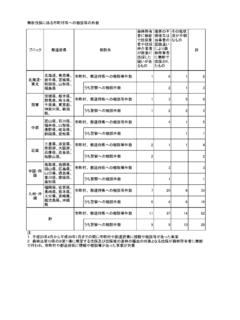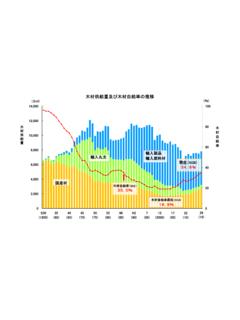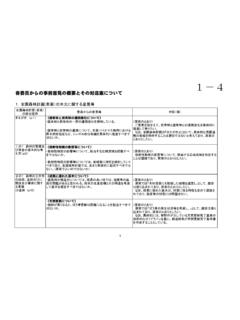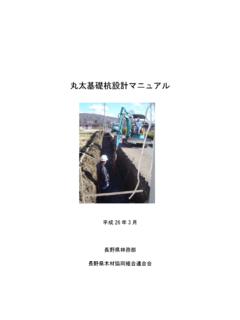Transcription of Annual Report on Forest and Forestry in Japan - …
1 Annual Report on Forest and Forestry in Japan Fiscal Year 2015 (Summary) Forestry Agency Ministry of Agriculture, Forestry and Fisheries, Japan The Annual Report on Forest and Forestry is a Report which the Japanese Government submits to the Diet every year, in accordance with article X of the Forest and Forestry Basic Act. This document is a summary of the Annual Report for FY2015. Table of Contents Forest and Forestry Topics in FY2015 .. 1 Chapter I Stable Supply System of Wood .. 3 Chapter II Forest Management and Conservation .. 9 Chapter III Forestry and Rural Mountain Communities .. 15 Chapter IV Wood Products Industry and Wood Use.
2 19 Chapter V National Forest Management .. 23 Chapter VI Reconstruction from the Great East Japan Earthquake .. 25 Appendix .. 27 Note: The maps of Japan included in this summary Report do not necessarily represent the territory of Japan Forest and Forestry Topics in FY2015 TOPIC 1. Self-Sufficiency Ratio of Wood Exceeded 30% The self-sufficiency ratio of wood was in 2014, exceeding 30% for the first time in 26 years. The self-sufficiency ratio of wood hit the bottom of in 2002, but, since then, the ratio has been rising, with the increase of wood supply in recent years as planted forests are getting mature and use of domestic wood for plywood becomes popular.
3 The volume of wood used at woody biomass power plants is also increasing. Such energy use of wood contributes to vitalization of rural economy, as well as mitigation of climate change. TOPIC 2. Wood Use in the Tokyo 2020 Olympic and Paralympic Games The Tokyo 2020 Olympic and Paralympic Games are to be held in 2020. Wood use in facilities for the Games would provide people with the opportunities to understand Japan s technologies based on its traditional wood culture as well as the importance of wood use . The Working Team on Wood Use , composed of the national government, the Tokyo Metropolitan Government and the Tokyo Organizing Committee of the Olympic and Paralympic Games, are promoting wood use in the facilities associated with the Games.
4 The construction plan for the New National Stadium Japan , which will be the main stadium for the Olympic and Paralympic games, was decided in August 2015. The structure of the stadium s roof will be a hybrid of iron and wood.. In addition, cross laminated timber (CLT) will be used for the interiors of the stadium. Image of New National Stadium Japan Image Taisei Corporation / Azusa Sekkei Co., Ltd and Kengo Kuma and Associates Joint Venture / JSC presents. Fig. Self-sufficiency ratio of wood 02040608010002,0004,0006,0008,00010,0001 2,00014,00019556065707580859095000510 Imported fuel woodImported wood productsImported roundwoodDomestic timberSelf sufficiency rate for wood (right axis)(10,000m3)( ) Year (roundwood equivalent)2 TOPIC 3.
5 Wood Use in 2015 Milan Universal Exposition In 2015, the Universal Exposition was held in Milan, Italy, with the theme of Feeding the Planet, Energy for Life . The Japan Pavillion was built with a wooden exterior wall of Japanese larch (karamatsu). Japan s traditional wooden structure with seismic resistance was applied to this wooden exterior wall, and sliced veneer of Japanese cedar (sugi) was used for the interior wall of the room. The 2015 Milan Universal Exposition provided a precious opportunity to disseminate Japan s tradition and the beauty of wood use to all over the world, which helps promote the export of Japan s Forest products.
6 TOPIC 4. The Paris Agreement Adopted at COP21, recognizing the Importance of Forests The twenty-first session of the Conference of the Parties (COP21) of the United Nations Framework Convention of Climate Change (UNFCCC), held in Paris in 2015, adopted the Paris Agreement , which provides a legal framework for the global action against the threat of climate change beyond the year of 2020, in which all the Parties are to join. This Agreement also provieds that Parties should take action to conserve and enhance, as appropriate, sinks and reservoirs of greenhouse gases, including forests. The Government of Japan , prior to COP21, submitted its Intended Nationally Determined Contribution (INDC) to the Secretariat of UNFCCC.
7 This INDC sets Japan s greenhouse gas (GHG) emisions target at the level of a reduction by the fiscal year (FY) 2030 relative to FY2013, of which needs to be secured by Forest carbon sinks measures. TOPIC 5. The 100th Anniversary of the Protected Forests System in the National Forests The year 2015 marked the 100th anniversary of the Protected Forests System in National Forests. The Forestry Agency has designated National Forests with highly valuable biodiversity as Protected Forests and strictly protected them. This system has also served as a protection mechanism for sites of World Natural Heritages and Biosphere Reserves in Japan , while presenting a Forest management model to successfully strike a balance between Forestry and nature conservation, and deepening people s understanding of zoning in Forest management.
8 In September 2015, the Forestry Agency revised the Protected Forests System to reorganize the classification, introducing a new idea of restoration measures, and establishing an efficient management structure, based on accumulated scientific expertise. Adoption of the Paris Agreement Protected Forest in World Heritage Shirakami Wooden exterior wall of Japanese Pavilion room inside 3 Chapter I Stable Supply System of Wood 1. Matured Forest Resources and Trends of Demand/Supply of Timber Matured Forest Resources and Transforming Forestry into a Growth Industry In Japan , Forest resources, especially those forests planted after World War II, have grown mature, fully ready for harvest ( ).
9 Multi-functionality of matured forests can be secured through efforts for continuous utilization of Forest resources on a cycle of planting, thinning, harvesting and re-planting. On the other hand, Forestry in Japan has been stagnant due to its low profitability. The productivity of Forestry activities remains relatively low, due to structural characteristics of small-scaled Forest ownership dominance, low level of coordination and consolidation of Forestry practice, under-development of Forestry road network and insufficient introduction of efficient log production systems. In addition, rural mountain communities, where people engaged in Forestry are living, are still placed in serious situations like depopulation and the increase of elderly people.
10 In order to promote Forestry and Forest products industry as well as development of the rural communities, it is vital to promote continuous utilization of Forest resources and establish a stable supply system of wood with a view to transforming Forestry into a growth industry. Trends of Wood Demand/Supply The structure of wood demand is changing. With the changes of Japanese life styles, demand for high-grade timber, such as knot-free has decreased, while demand for regular timber, dried timber and laminated timber with stable quality and performance has increased. The plywood industry uses domestic timber more than ever, with improved processing technology.












